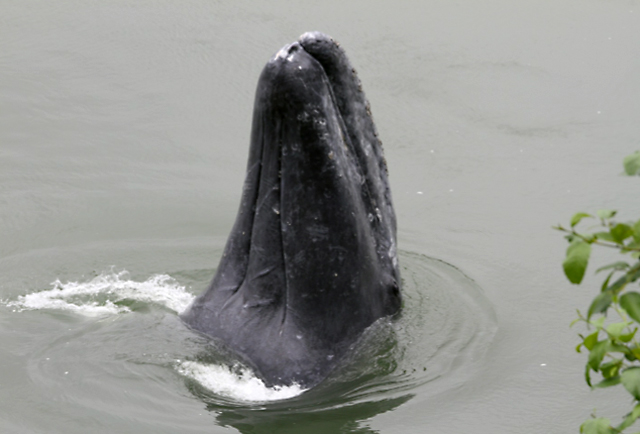
Scientists still aren’t sure what caused the behemoth mammals to stray into fresh water or why they stayed so long. But the occurrence offered students and lucky passersby a unique opportunity to view the majestic creatures up-close.
As is typically the case, scientists with the National Oceanic and Atmospheric Administration immediately called Humboldt State Zoology Professor Dawn Goley, who directs the Marine Mammal Education and Research Program (MMERP) at HSU. Over the course of several weeks, Goley and her students worked closely with NOAA, the National Marine Fisheries Service and the Yurok Tribe, which owns part of the river, to study the mammals and lure them back to salt water.
At first, scientists were concerned that the calf, which appeared between five and eight months old, was growing thin. But after three weeks, it left the river and was spotted swimming at the mouth of the ocean. After that, scientists teamed with agencies along the coast to encourage the mother to return to sea by following her in boats and clanking on pipes underwater. They hoped that the noise would act as enough of an irritant that the whale would move downstream. When that tactic didn’t work they played killer whale feeding calls into the river to try to evoke a flight response.
Goley and her students continuously monitored the mother’s condition, taking photographs of her skin from the riverbank and listening to her calls underwater. Scientists were worried that prolonged exposure to fresh water and algae would damage her skin or that fishing boats would leave her agitated. Since water levels in the river drop during the summer, there was also concern she would become stranded.
Gray whales are generally difficult to study in the wild because of their size – they can reach up 50 feet in length and weigh 36 tons – and because they migrate vast distances between their summer feeding grounds in the Arctic Ocean and their winter breeding grounds in Baja California. A small number of whales forego their full northern migration and feed along the coasts of the Pacific Northwest. Goley and her students have been studying whales that feed in the waters of Humboldt and Del Norte County for 15 years. But never in a river and never up-close.
“This was an incredible educational experience for the students and me,” says Goley, whose program is open to both undergraduate and graduate students. “They’ve really come to not only know the gray whales, but the nature of the Klamath River and the Yurok who call the river home.”
MMERP emphasizes field research, which means that students conduct long-term studies of marine mammals on the North Coast. Current projects include the tagging and tracking of harbor seals, surveying offshore rocks for Steller sea lions and surveying offshore and near shore waters for gray whales.
“Our surveys usually entail watching whales from a distance, taking their photos, then having the whales travel away from you,” says Allison Fuller a Biology graduate student who has conducted whale surveys for MMERP for four years. “To sit on a river bank and watch a whale less than 50 feet away for hours upon hours is so different than anything I or MMERP has ever done before. It’s been amazing.”
Ashley Donnell (’11, Marine Biology) agrees: “To work with scientists and the tribe and to experience such an amazing animal has been very rewarding. It’s really been a once-in-a-lifetime opportunity.”
The last time a gray whale drifted into the Klamath for an extended period of time was in 1989. The whale fed in the river for several months before returning to the ocean on its own. In 2007, a pair of humpback whales attracted media attention when they wandered into the Sacramento River for two weeks before returning to sea.